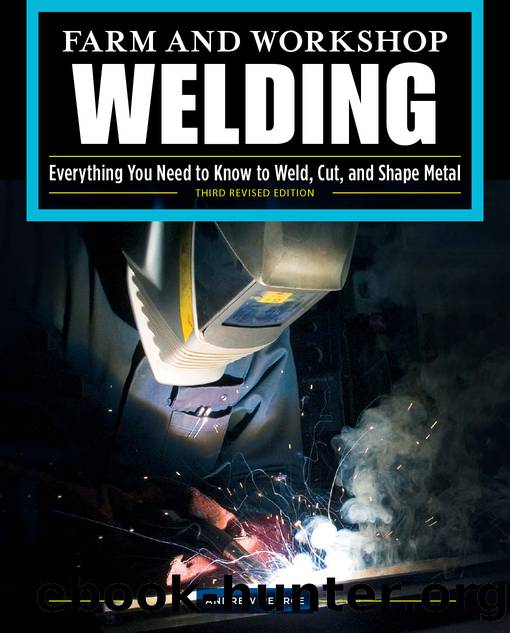Farm and Workshop Welding, Third Revised Edition by Andrew Pearce

Author:Andrew Pearce
Language: eng
Format: epub
Publisher: Fox Chapel Publishing
5.20. Not the best of fillets. Using a small flame and travelling at varying speed produced a jumble of poor fusion and misses. But things improved a bit as work progressed leftwards along the joint; short sections (a and b) are better, though undercut is on show at the top edge of (a).
Lap joints are just miniature fillets.
Work fast, overcoming the bottom plateâs heat-sink effect by using a stronger flame or bigger nozzle than for the equivalent butt. Judge filler quantity and speed of travel so that the upper plateâs top edge is just fused in to the joint.
GOING VERTICAL WITH GAS
This isnât too hard. Travel is upward for preference as gravity makes of a mess of the pool coming down, and unlike with arc processes there are no magnetic forces to help hold weld metal in place and direct it to the pool.
Butt joints are prepared as for flat work, leaving a penetration gap equal to or just bigger than plate thickness. Rod and flame angles stay much as they were, only shifted through 90° (5.21). Bend the rod into a hook shape and hold it alongside the joint so the tip points down to the weld pool: this stops burnt fingers.
Use the bottom tack as a starting point. Make a pool from this and add a little rod. Once an onion-shaped hole appears over the pool you know penetration is complete, though in thin sheet the âonionâ might not be necessary. If one doesnât magically pop up, either steepen the flame or physically push it down into the joint root to open up a hole.
When the âonionâ appears, move upwards at a rate that maintains it, adding filler rod to the pool as you go. This may sound difficult, but itâs easier to do than to read about.
Overhead gas welding isnât so simple. Thereâs no magnetic transfer of filler, so gravity wants to dump the weld pool into your lap.
This painful tendency is reduced by keeping nozzle size to the minimum consistent with good fusion, and working quickly. Rod and blowpipe angles can be steeper that normal; try bringing them toward a right-angle with the work.
If youâre not happy with the notion of welding uphill or overhead, time wonât be wasted in dismantling something so you can weld it on the flat. Better spend a while with the spanners than have a job fail in use.
Bronze Welding
A soft, quiet and thoroughly enjoyable pastime is this. Rather than melting parent metals, bronze welding uses a copper/zinc alloy as a âglueâ to hold things together or build up worn surfaces. The bond is formed partly from the filler metal hooking into tiny surface features on the joint faces, and partly from controlled local diffusion â but never melting â into the base metal.
From Soft Solder to Hard
Bronze welding, brazing, silver soldering and soldering are all related. The key difference from fusion work is that the parent metals are never melted. Instead, the filler acts like a glue to bond surfaces to each other.
Download
This site does not store any files on its server. We only index and link to content provided by other sites. Please contact the content providers to delete copyright contents if any and email us, we'll remove relevant links or contents immediately.
| Automotive | Engineering |
| Transportation |
Whiskies Galore by Ian Buxton(41524)
Introduction to Aircraft Design (Cambridge Aerospace Series) by John P. Fielding(32881)
Small Unmanned Fixed-wing Aircraft Design by Andrew J. Keane Andras Sobester James P. Scanlan & András Sóbester & James P. Scanlan(32567)
Craft Beer for the Homebrewer by Michael Agnew(17926)
Turbulence by E. J. Noyes(7690)
The Complete Stick Figure Physics Tutorials by Allen Sarah(7134)
Kaplan MCAT General Chemistry Review by Kaplan(6584)
The Thirst by Nesbo Jo(6432)
Bad Blood by John Carreyrou(6270)
Modelling of Convective Heat and Mass Transfer in Rotating Flows by Igor V. Shevchuk(6218)
Learning SQL by Alan Beaulieu(6023)
Weapons of Math Destruction by Cathy O'Neil(5819)
Man-made Catastrophes and Risk Information Concealment by Dmitry Chernov & Didier Sornette(5638)
Digital Minimalism by Cal Newport;(5382)
Life 3.0: Being Human in the Age of Artificial Intelligence by Tegmark Max(5181)
iGen by Jean M. Twenge(5149)
Secrets of Antigravity Propulsion: Tesla, UFOs, and Classified Aerospace Technology by Ph.D. Paul A. Laviolette(4973)
Design of Trajectory Optimization Approach for Space Maneuver Vehicle Skip Entry Problems by Runqi Chai & Al Savvaris & Antonios Tsourdos & Senchun Chai(4837)
Electronic Devices & Circuits by Jacob Millman & Christos C. Halkias(4739)
